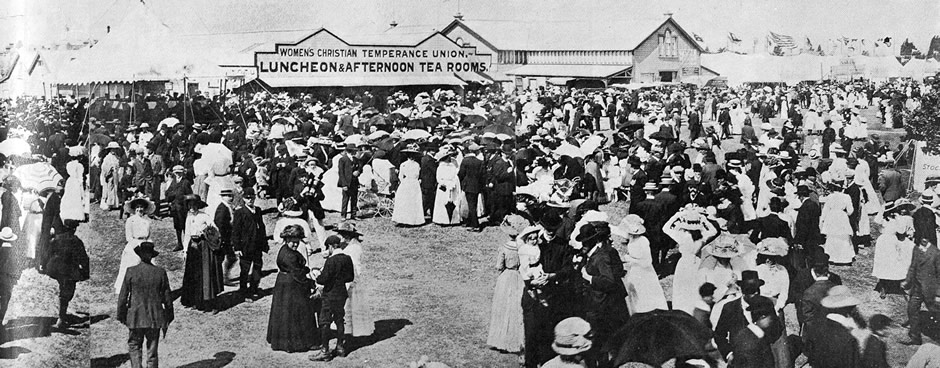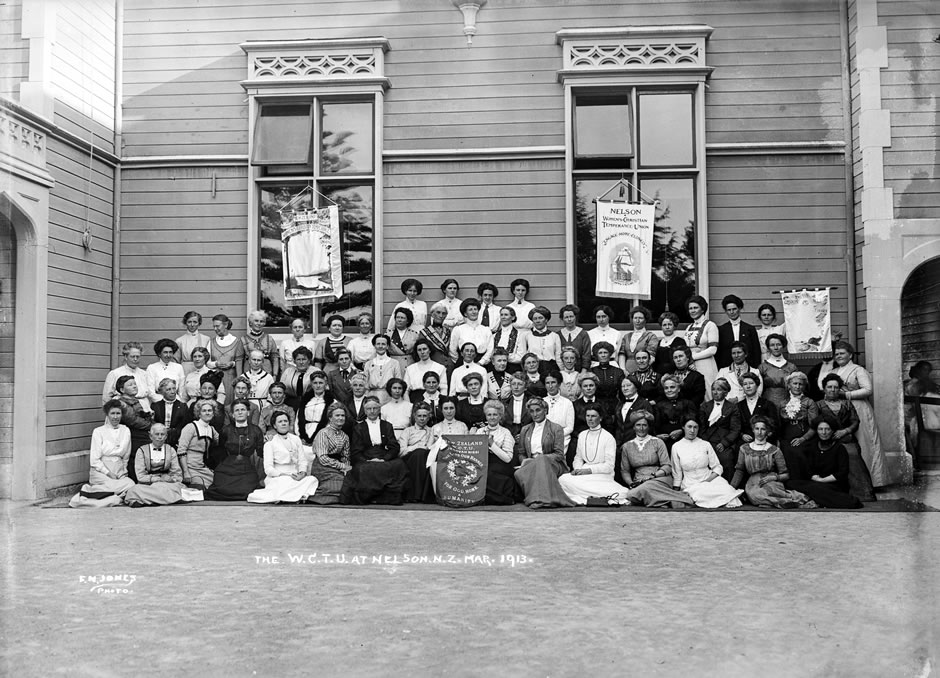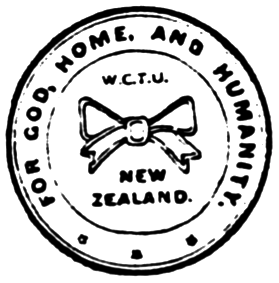This essay written by Raewyn Dalziel was first published in Women Together: a History of Women's Organisations in New Zealand in 1993. It was updated by Raewyn Dalziel in 2018.
1885 – 1993
The Women's Christian Temperance Union (WCTU) was by 1993 the oldest surviving national organisation of women in New Zealand. From the time it was founded in 1885, it worked to promote temperance, Christian values, and social reform, and to abolish the trade in alcohol and drugs. The membership of the WCTU peaked in the late 1920s at around 7700. In 1993 it had about 600 members.
New Zealand women were no strangers to temperance when they were first introduced to the WCTU. Signing the pledge was a commitment undertaken by numbers of settler women in the mid-nineteenth century, and temperance meetings were regular events. Women joined the Order of Good Templars from its inception in New Zealand in 1872, and a women's temperance group was formed in Invercargill in August 1884.
The WCTU was founded in the United States in 1874, following the phenomenal success of a women's crusade against alcohol in the mid-West states. In 1879 Frances Willard, an inspirational and ambitious leader, was elected president of the American WCTU and embarked on a 'Do Everything' policy. She initiated the Polyglot Petition, to be signed by women of all nations, calling on world leaders to outlaw alcohol and opium. In the early 1880s Willard began to send missionaries overseas, and in 1885 Mary Leavitt visited Australia and New Zealand to bring the message of the World's WCTU.
Leavitt spent five months in New Zealand, delivering lectures and establishing branches of the union. The first was in Auckland, presided over by Anne Brame; six others followed. After Leavitt's departure, her work was taken over by Anne Ward, a prominent church worker and wife of Judge Charles Dudley Ward. Ward established a further seven unions, and became the first national president at a national convention held in Wellington in February 1886.

Canterbury Museum, Bishop Collection. Weekly Press, 16 November 1910.
The Women's Christian Temperance Union (WCTU) ran tearooms at A & P (agricultural and pastoral) shows – including these ones at the Christchurch show in 1910.
The WCTU operated through departments, each under the control of a superintendent and responsible for an area of work. Departments covered temperance literature, juvenile work, prison work, social purity, Sunday school activity, dress reform, franchise and legislation, and much else besides. The franchise and legislation department quickly became the most prominent. In America, Willard had identified women's suffrage as the 'Home Protection Ballot' and persuaded the WCTU to campaign for the vote. In New Zealand the first franchise superintendent was Mrs G. Clarke, followed in 1887 by Kate Sheppard.
All women who joined the WCTU took a pledge of total abstinence, and the union co-operated with the New Zealand Alliance, formed in 1886, to work for the suppression and prohibition of the liquor trade. The union's first major campaign was to stop the employment of barmaids, whose presence in pubs was seen both as demoralising to women and as enticing men to drink. In some towns WCTU women set up tea and coffee shops to compete with the bars and often provided non-alcoholic refreshments at local events such as Agricultural and Pastoral shows.
The WCTU campaigned for local 'no-licence' and prohibition in the liquor referenda that were held every three years from 1894. In 1911 Annie Driver of Dunedin organised a women's 'crusade', adopting the motto 'lips that touch wine shall not touch mine', in order to win support for prohibition. Although over half the voters in that referendum favoured national prohibition (a three-fifths majority was needed to carry the reform), the result was more a continuation of the swing towards prohibition of the preceding years than a triumph for the crusade. The vote for prohibition was never as high again.
Temperance work among Māori began in 1894 when Ellen Hewett was appointed superintendent of a Māori department. Temperance pamphlets and pledge cards were printed in Māori, and at the first Māori convention, held in 1911, seven Māori unions were represented. Hēni Pore (Te Arawa) was prominent in the WCTU in the early twentieth century. Probably the best known Pākehā to work with Māori women for temperance was Florence Harsant, who travelled extensively in the north and on the East Coast before World War I. From 1943 to 1959, the WCTU operated a hostel for Māori girls in Auckland. The WCTU emphasised the need to encourage temperance among young people. It had a Cradle Roll of children whose mothers pledged to rear them as abstainers, and a union for boys and girls known as the Loyal Temperance Legion.
Following the 'Do Everything' policy, the WCTU worked for social reform on a broad front. Its members visited prisons, set up kindergartens and ran clubs for young mothers. In Dunedin, Leavitt House (the former Star and Garter Hotel) provided evening classes in cooking, sewing, carpentry and bible instruction and a club for boys. In port towns facilities were established for visiting seamen, the first Sailors' Rest being opened in Dunedin in 1888.
The WCTU has been seen as providing 'a bridge between home and church, on the one hand, and social and political action ... on the other'. [1] Involvement in the WCTU led women to see that social and political action was possible, and that to be effective they must have the vote. Under Sheppard's leadership, the WCTU spearheaded the franchise movement, organising suffrage meetings, collecting signatures for petitions, lobbying politicians and publishing pamphlets. In 1892 WCTU women collaborated with non-temperance women in establishing Franchise Leagues to widen the appeal of the suffrage movement. In 1893 their campaign was finally successful. Three years later WCTU members were prominent in establishing the National Council of Women (NCW).
The New Zealand WCTU, as a branch of the World's WCTU, linked New Zealand women to an international movement. Sheppard attended the World's WCTU biennial conference, presided over by Willard, in London in 1895. Correspondence with renowned temperance leaders such as Willard and Lady Henry Somerset, access to international temperance literature, attendance at conferences and the two-way movement of missionaries (Anderson Hughes-Drew was a New Zealander who was an official round-the-world missionary for the World's WCTU), all linked New Zealand women in a global sisterhood.
After some years in which The Prohibitionist carried a page of women's news, the WCTU began its own journal, The White Ribbon, in May 1895. Sheppard was the first editor, followed by Lucy Lovell-Smith (1903-08). The longest serving editor was Nellie Peryman (1913-45). In 1965 The White Ribbon became The New Zealand White Ribbon Digest.

Nelson Provincial Museum, F N Jones Collection: 321301.
Women's Christian Temperance Union conference, Nelson, March 1913.
The WCTU mapped out its territory in the late nineteenth century. High among its goals was social purity. It attacked the double standard applied to male and female sexual behaviour, advocating that the moral standards expected of women should apply to all. It worked for the repeal of the Contagious Diseases Act 1869, which discriminated against women and upheld prostitution. In the twentieth century some new issues appeared, in particular those associated with the behaviour of the young and with mass entertainment, but the goals of the WCTU remained the same. In accordance with its own perspective on the home and family, the WCTU criticised some contemporary moves towards equality for women, such as the United Nations Convention for the Elimination of All Forms of Discrimination Against Women (CEDAW) and the Working Women's Charter; in the past it also took a strong stand against homosexuality.
In the 1990s, members of the WCTU were grouped together in local unions, each with its own officers. These in turn were grouped in district unions, which also had an executive committee consisting of an elected president and other officers of the constituent unions. The national union had an elected president and other officers. The WCTU has been led by some outstanding women. In the first generation, national presidents Annie Schnackenberg (1892-1900), Lily Atkinson (1901- 05), Rachel Don (1914-26) and Elizabeth Taylor (1926-35) were women of wide interests and considerable influence. In later years the WCTU's impact on the national scene declined, but long-serving presidents such as Constance Toomer (1952-58, 1966-68) and Catherine Polglase (1969-1990) were significant figures in women's social and religious activity.
Raewyn Dalziel
1994 – 2018
After 1993, the WCTU continued to campaign against the availability and sale of alcohol and widened its programme to include education of the public on the adverse effects of tobacco and illicit drugs. Although membership declined further, the Union still held annual conventions and sent representatives to the triennial conventions of the international body. New Zealand’s Margaret Jackson presided over the World Union between 2001 and 2004. The White Ribbon Digest ceased publication in 2011 and was replaced by a website, blog and online newsletter. True to its political origins, the WCTU focused on submissions to Parliament on social issues related to home and family. It consistently maintained a conservative stance on abortion and advocated for reducing the number of licensed premises and hours of opening for the sale of alcohol, raising the legal age for its purchase, and banning liquor advertising and sponsorship. In 2018, the WCTU demonstrated a strong appreciation of its history and, in particular, the crucial role its founders played in gaining women’s suffrage.
Raewyn Dalziel
Notes
[1] Tyrrell, 1983, p. 285.
Unpublished sources
McKimmey, P.F., 'The Temperance Movement in New Zealand, 1835-1894', MA thesis, University of Auckland, 1968
Nelson Teetotal Pledge Book, 1842-1871, Bert Collection, Nelson Provincial Museum
Women's Christian Temperance Union papers, 1882— 1988, ATL
Women's Christian Temperance Union scrapbooks and other records, WCTU National Headquarters, Nelson
Published sources
Bordin, Ruth, Woman and Temperance: The Quest for Power and Liberty, 1873-1900, Temple University Press, Philadelphia, 1981
Bunkle, Phillida, 'The Origins of the Women's Movement in New Zealand: The Women's Christian Temperance Union 1885-1895', in Phillida Bunkle and Beryl Hughes (eds), Women in New Zealand Society, George Allen & Unwin, Sydney, 1980, pp. 52-76
Cocker, J., and J. Malton Murray, Temperance and Prohibition in New Zealand, Epworth Press, London, 1930
Dougherty, Ian, Without Compromise: A Brief History of the New Zealand Women’s Christian Temperance Union, NZWCTU, 2013
Grigg, A.R., 'Prohibition and Women: The Preservation of an Ideal and a Myth', New Zealand Journal of History, Vol. 17 No. 2, 1983, pp.144-65
New Zealand White Ribbon Digest, 1965-1992
Tyrrell, lan, International Aspects of the Women's Temperance Movement in Australia: The Influence of the American WCTU, 1882-1914', Journal of Religious History, Vol. 12, 1983, pp. 284-304
Tyrrell, lan, Woman's World, Woman's Empire: The Women's Christian Temperance Union in International Perspective, 1880-1930, University of North Carolina Press, Chapel Hill, 1991
White Ribbon, 1895-1965
Wood, Jeanne, A Challenge Not a Truce: A History of the New Zealand Women's Christian Temperance Union 1885-1985, The Union, Nelson, 1986
Further information:
Hear Arabella Manktelow (1871-1963) talk about the link between women's suffrage and prohibition.


Community contributions